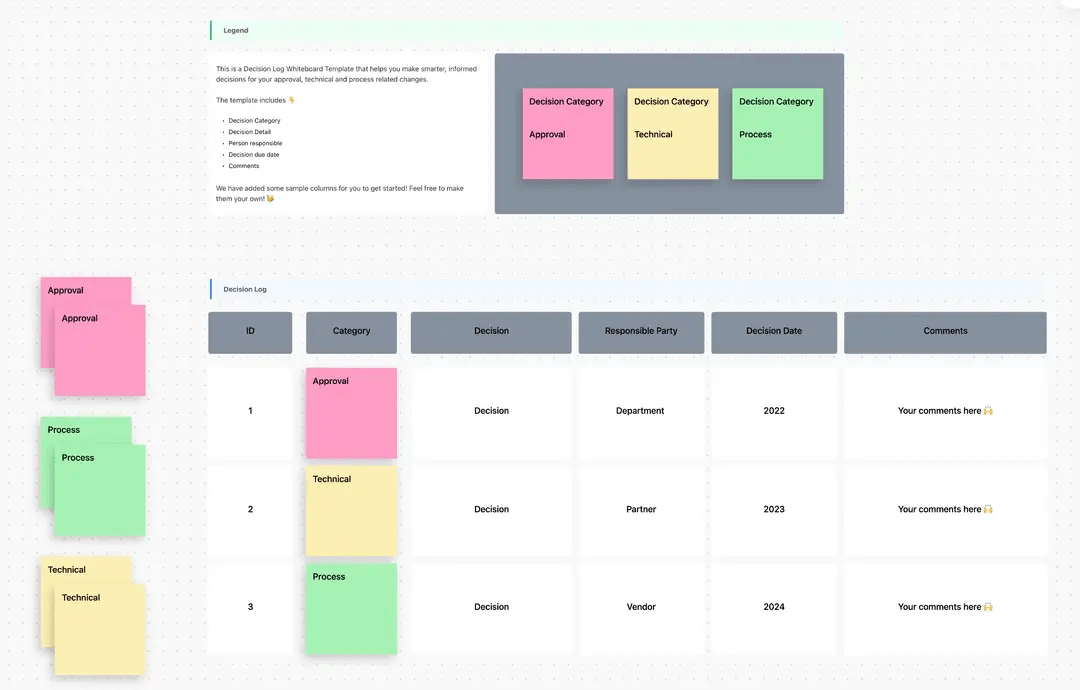

You must do several things right to be a successful entrepreneur or a leader. One of the most critical involves building a high-performing team.
However, building a high-performing team is more than bringing together talented individuals with specialized skills and expecting them to turn on the magic. It involves strategic decision-making, handpicking and nurturing talent, effective steering, building cohesiveness, and leading from the front.
This guide will show you how to build high-performance teams and motivate them to achieve more.
- What is a High-Performing Team?
- What Does it Mean to be a ‘High-Performing’ Team?
- The Benefits of Building High-Performing Teams for Organizations
- The Role of Leadership in High-Performing Teams
- The Seven Cs of Team Building
- How to Build a High-Performing Team?
- Step 1: Assemble a diverse team
- Step 2: Develop a shared sense of purpose
- Step 3: Delegate authority and decision-making
- Step 4: Foster two-way communication
- Step 5: Extend support and share resources
- Step 6: Cultivate empathy and emotional intelligence
- Step 7: Recognize contributions and celebrate achievements
- Step 8: Maintain flexibility and adaptability
- Step 9: Measure and assess performance
- Step 10: Establish a feedback mechanism
- Overcoming Challenges in Building and Sustaining High-Performing Teams
- How You Can Build High-performing Teams: Recap
- ClickUp: Your Enabler for Building High-Performance Teams
- FAQs
What is a High-Performing Team?
A high-performing team consists of talented individuals who work together to harness their collective strengths and deliver exceptional results. They derive this ability from combining complementary skill sets, diverse perspectives, and specialized expertise.
However, a high-performing team has as much to do with team dynamics as with skill and competency. These teams are characterized by their clarity of goal, shared values, effective communication, strong leadership, and a commitment to continuous improvement.
High-performance teams form the lifeblood of any establishment and play a pivotal role in setting the organizational culture. They help businesses pivot strategies, adapt to changing circumstances, foster innovation, and execute plans astutely.
This provides stability against uncertainties and sets the foundation for a positive workplace. With their collaborative spirit, active communication, and enthusiasm, these self-managing teams inspire others to excellence.
What Does it Mean to be a ‘High-Performing’ Team?
High-performance teams are highly engaged, motivated, and trustworthy. Here’s an overview of what they do distinctly that earns them the tag of a high-performing team:
They have a clear vision of their shared goals

High-performing teams have an undistorted vision of their goals, purpose, key priorities, and timelines. This keeps them moving in the same direction.
Staying focused on the team and individual goals leaves them undeterred while taking on challenges, distributing work, and assigning roles and responsibilities. They see the larger picture, align their activities with these overarching business objectives, and continue working towards them.
They have well-defined roles and responsibilities

High-performing team members understand how their role fits the organization’s business goals and objectives. This makes them keenly aware of their direct impact on the company’s performance and instills a sense of belonging within the team. Every team member aligns their activity to meet the overarching business goal. Paired with the strategic division of labor, the sense of purpose and direction improves efficiency, eliminates confusion, and promotes cohesion while allowing individuals to play to their strengths.
They are engaged and enthusiastic about their work
High-performance teams display a remarkable level of enthusiasm at work. These qualities are infectious, creating a positive and dynamic work atmosphere.
Team members are deeply invested in individual, team, and organizational goals and derive personal fulfillment from achieving them. Every goal achieved further ignites their shared passion and feeds a positive feedback cycle.
They communicate intentionally and openly
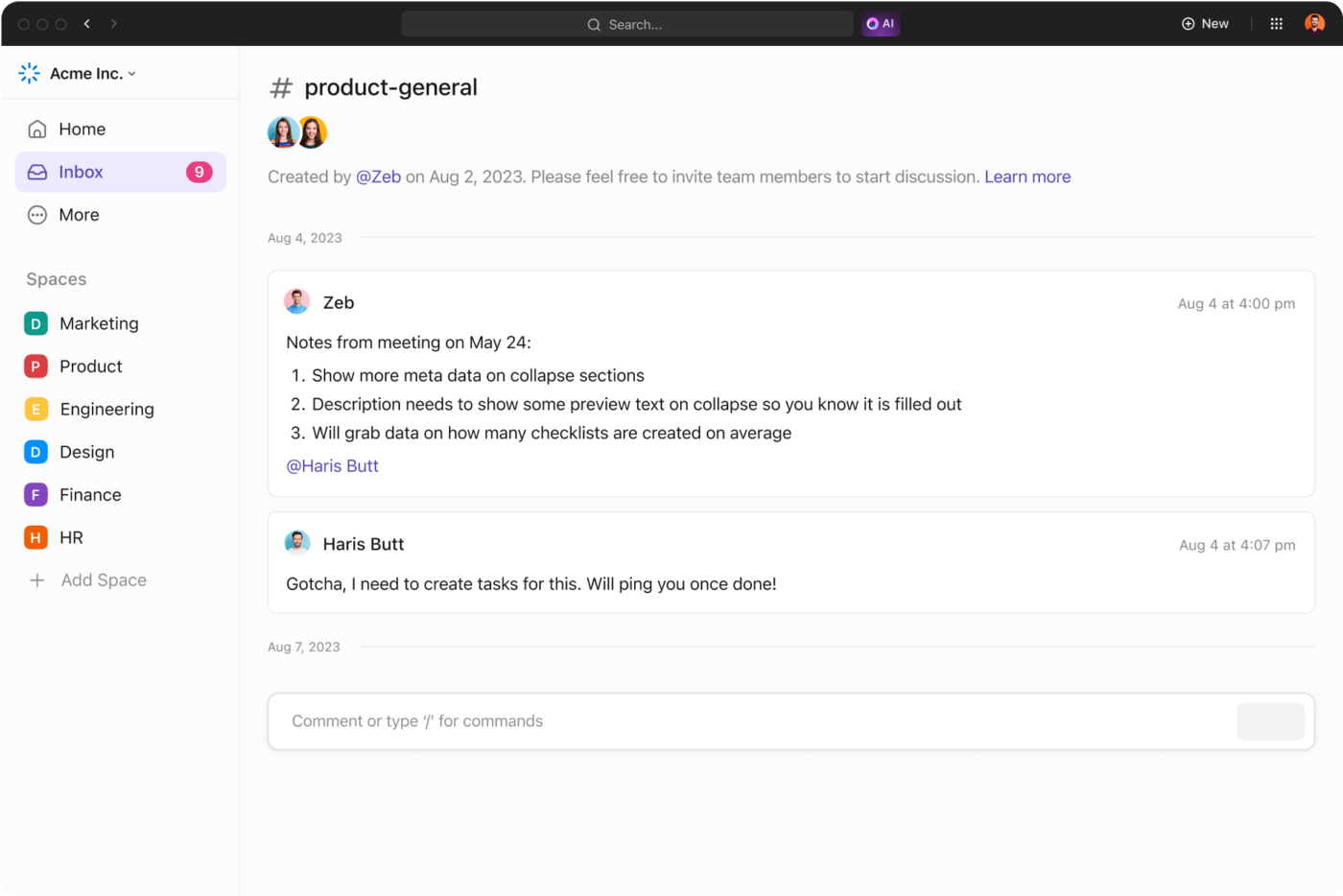
Communication is the pride and joy of a high-performing team. They value openness, transparency, and intent while communicating. The exchange of new ideas and information brings everyone on the same page. Team members have rational discussions to solve problems and make decisions. There is no ambiguity in their messages as everything is put forth clearly and concisely.
Such a focus on communication inspires a feeling of belonging, minimizes misunderstanding, promotes collaboration, stimulates informed decisions, and much more—essentially, everything that makes a high-performance team ‘high-performing.’
They consider feedback to be a two-way dialog
High-performing project teams view feedback as a two-way dialog. This stems from their culture of openness and transparency. Here, team members actively seek and provide constructive feedback to learn from one another and improve their performance collectively.
Treating feedback as a dialog creates an environment where diverse perspectives are valued, and team members feel encouraged to share insights.
They strive for continuous improvement
A culture of continuous improvement is a sign of high-performing teams. They constantly seek ways to enhance their processes, skills, and outcomes.
This pursuit of skill enhancement is so deeply ingrained in the team’s mindset that they proactively seek growth areas and feedback as catalysts for positive change.
They learn from successes and setbacks from regular assessments, performance reviews, learning initiatives, and feedback loops.
They trust and respect each other
High-performance work teams thrive on the foundations of trust and mutual respect.
Trust results from consistent and reliable behavior, where team members can depend on each other to fulfill their commitments.
Respect acknowledges their diverse perspectives, skills, expertise, and contributions, creating an inclusive and collaborative atmosphere.
They take accountability for their work
Since high-performing teams are so deeply invested in their work, their working style is characterized by a strong sense of accountability. They take complete ownership of their responsibilities and consistently deliver on commitments by holding themselves and their team members to high standards.
Such accountability is rooted in a shared commitment to achieving goals and a collective belief in the impact of individual contributions on overall team success. This sense of accountability makes them results-oriented, resilient, and adaptable.
They foster an environment of innovation and creativity

Innovation and creativity are the cornerstones of high-performing teams. The varied but complementary skills and diverse perspectives set the stage for experimentation.
At the same time, team members feel empowered to voice their opinions without the fear of judgment, which further catalyzes out-of-the-box thinking.
From collaborative working to brainstorming sessions, the high-performing team views challenges as opportunities to flex their innovative and creative muscles.
They are masters of conflict resolution
Effective conflict resolution is a core part of a team’s performance. A high-performing team focuses on a constructive and solution-oriented approach to resolving disagreements. They seek common ground by actively listening to different viewpoints and perspectives rather than avoiding conflicts entirely.
Team leaders are crucial in managing conflicts by encouraging respectful discussions while maintaining a harmonious work environment.
They celebrate milestones and acknowledge individual contributions
Recognizing the achievement of big and small goals is an integral component of a high-performing team culture. It helps motivate team members and builds a positive environment.
Leaders of high-performing teams make it a point to acknowledge and appreciate the individual contributions of each team member. Such celebrations boost morale and serve as a reminder of shared accomplishments.
They can effectively recalibrate workloads
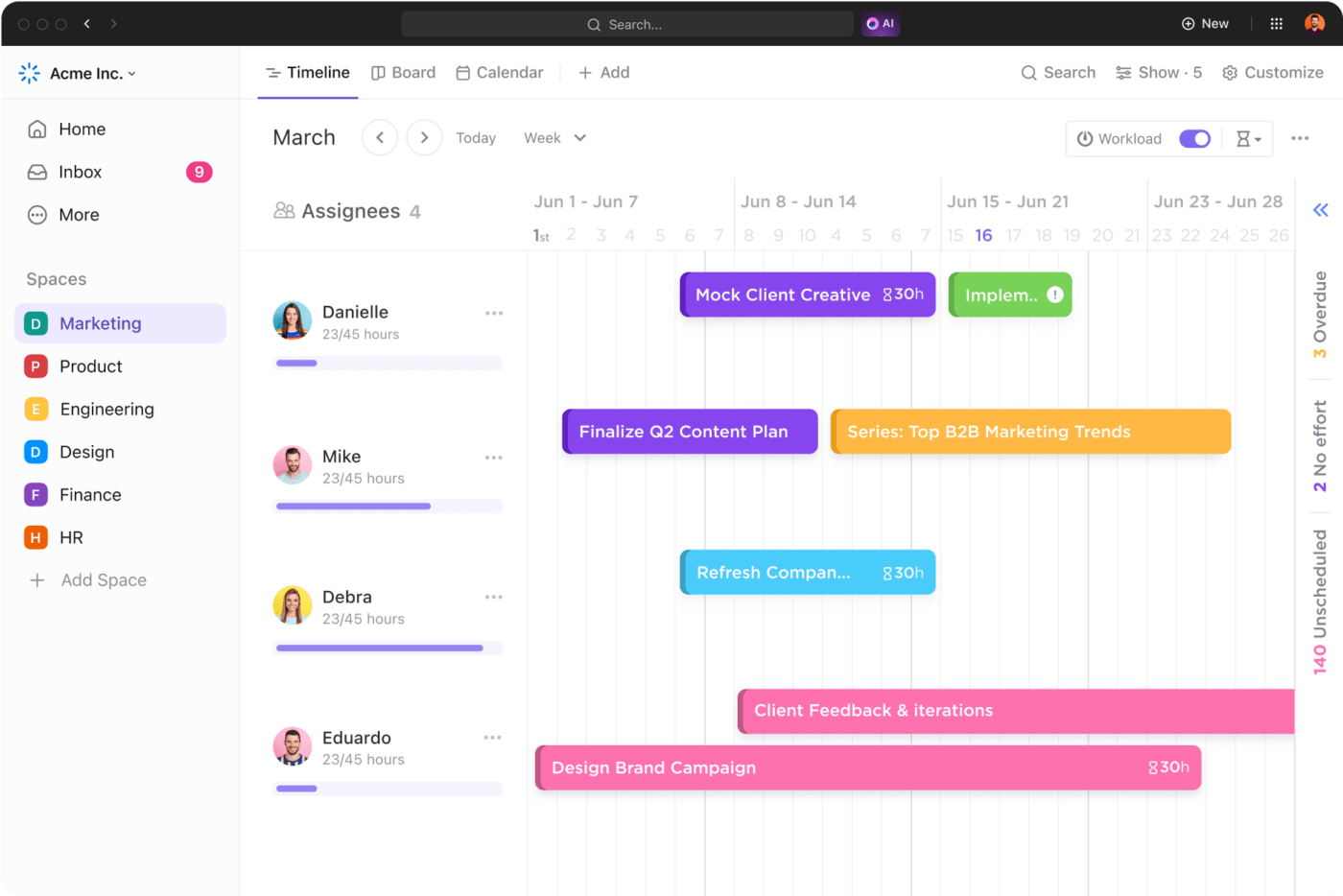
Even though high-performance teams have a leader at the helm, they are also self-managing teams. Since every team member brings expertise to the table, everyone is open to exchanging ideas and collaborating as a team. They understand the larger goal and can proactively recalibrate workloads for optimal efficiency and adaptability.
Such flexibility lets them respond swiftly to changing circumstances while maintaining productivity and growth at a sustainable pace.
They balance short-term goals with long-term objectives
High-performing teams display a remarkable ability to balance short-term goals with long-term objectives. As agile, highly adaptable teams, they orchestrate their day-to-day tasks considering the short-term goals.
At the same time, they map these short-term goals to broader organizational objectives, bringing about a strategic alignment.
Traits of a high-performing team summarised:
- Focused on shared goals and purpose
- Clear roles and responsibilities
- Enthusiastic and engaged at work
- Rational and open communicators
- Believe in constructive feedback
- Seek learning and growth
- Inclusive, respectful, and collaborative
- Show ownership and commitment to team goals
- Innovative and creative
- Solution-oriented approach to conflicts
- Appreciate each other
- Flexible and adaptable
- Combine short-term actions with long-term vision
The Benefits of Building High-Performing Teams for Organizations
High-performing teams contribute to organizational success by offering the following benefits:
- Increased productivity: High-performing teams are highly efficient and purpose-driven, which can boost productivity by an impressive 20-25%
- Innovation and creativity: They are advocates of innovation and encourage others to share their ideas, explore creative solutions, and experiment, which results in unconventional breakthroughs and advancements
- Higher employee morale: Members of a high-performing team experience a heightened sense of job satisfaction and accomplishment after completing every project. Their infectious spirit contributes to a positive work environment and higher morale
- Positive work culture: In addition to inspiring other employees through their exemplary performance, high-performing teams lay the foundation for a high-functioning and supportive organizational culture
- Sharper problem-solving: High-performance teams have mastered the art of problem-solving. Whether it is through their complementary skills or their collaborative working styles, they manage to address challenges more effectively
- Adaptability to change: High-performing teams are highly resilient and responsive to changes in the business environment. This quality makes the team extraordinarily agile, adapting to evolving circumstances
- Optimum talent utilization: The composition of a high-performing team allows every member to play to their strengths. At the same time, the complementary skills compensate for any talent gaps. Such a structure maximizes individual talents through collective efforts
- Clear communication: High-performing teams prioritize open and transparent conversations focused on a shared understanding of common goals and objectives
- Engaged employees: Team members feel heard, seen, and acknowledged, which engages them actively in the work and keeps them committed to the team’s success
- Continuous improvement: High-performing teams have a mindset aimed at continuous improvement. It makes them open to constructive feedback, insights on process enhancements, and performance reviews
- Employee retention: High-performing teams deliver results, celebrate milestones, and resolve conflicts effectively. The resulting positive work culture is a powerful magnet that retains talent as everyone shares a feeling of kinship and belonging—to the team and the organization
The Role of Leadership in High-Performing Teams
Although a high-performance team is self-managing, leaders play a central role in creating, guiding, inspiring, and enabling the group’s collective success.
For one, they are the initiators and key decision-makers in the high-performing team-building process. They handpick talent based on the required skills and team goals in consultation with other stakeholders.
Next, they guide high-performance work teams by setting clear strategic goals. Such strategic direction helps the teams develop roadmaps or actionable plans to achieve the goal.
The leader may also recognize and leverage the team members’ diverse strengths for specialized roles. They actively participate in decision-making and facilitate innovation.
Leaders can also nurture talent by encouraging members to participate in professional development programs or courses. They may also introduce team-building exercises to improve collaboration and cohesion.
In case a member of such a team experiences a dip in performance, leaders can step in to diagnose and help them course-correct. This might involve everything from pep talks and conflict resolution to performance improvement plans.
ClickUp’s Corrective Action Plan Template helps teams take corrective action and address performance and compliance issues. It helps identify gaps in processes, analyze root causes, and develop a plan of action to prevent recurrence.
By cultivating individual and collective excellence, leaders inspire and motivate team members to work toward sustained success.
Team leaders are the ship’s captains, ensuring a safe voyage.
The Seven Cs of Team Building
Before we detail the process of building high-performing teams, let’s explore the 7Cs of a successful team. These 7Cs were proposed as drivers of teamwork by Tannenbaum and Salas, and include:
Capability
Capability focuses on every team member’s skills, knowledge, and competencies. Leaders should select team members with complementary skills and encourage them to nurture strengths or areas of expertise. They must ensure that the collective capabilities are broad enough to align with the project requirements.
Cooperation
Cooperation refers to the willingness of the team members to work with each other toward a shared objective.
Cooperative teams have members who support one another, share knowledge and resources, and contribute to a culture of mutual assistance. The resulting feeling of camaraderie and unity helps in building cohesive teams.
Coordination
Coordination relates to the synchronization of team efforts. Here, the high-performing team aligns its skills and activities to perform tasks smoothly without delays, bottlenecks, or hold-ups.
Such a level of cross-functional collaboration requires thorough planning followed by seamless execution,
Communication
Communication is the cornerstone of any high-performance team. Transparent and effective communication ensures the team members are all on the same page.
Combine strong communication with active listening to foster trust, reduce misunderstandings, and encourage collaboration.
Cognition
Cognition focuses on the team’s collective ability to think critically, solve problems, innovate, and make informed decisions. It results from cognitive diversity, with each individual offering fresh perspectives on the challenge.
The team’s collective expertise and intellect allow them to analyze situations holistically to generate creative solutions while maintaining a high degree of flexibility to adapt to changing circumstances.
Coaching
The team leader is the coach of a high-performance team. They offer guidance, mentorship, and support to boost performance. Coaches recognize each member’s unique strengths, areas of improvement, and those of the team. From identifying skill gaps to evaluating team performance, coaching helps teams perform.
Conditions
Conditions cover an array of external factors influencing high-performance team dynamics, such as work environment, resource availability, organizational support, etc. Leaders must maintain conducive conditions and provide the enablers that a high-performing team requires to function effectively and deliver outstanding results.
How to Build a High-Performing Team?
Let’s now focus on the primary question—how to build high-performance teams. The following is a 10-step guide to creating an agile team of high performers and how ClickUp helps you along this journey:
Step 1: Assemble a diverse team
Building high-performing teams requires careful consideration. Everyone is like a jigsaw piece that should fit the puzzle and contribute to the larger picture. The resulting team will be well-rounded and possess a multi-dimensional understanding of complex issues to pitch various solutions.
You want to assemble diverse individuals with varied skills, backgrounds, experiences, personalities, and perspectives—each bringing unique strengths. Their multi-faceted thoughts and ideas encourage innovation and creativity while developing resilience to tackle challenges.
At the same time, bringing together cross-functional teams across departments creates a diversity of thought, skill, and understanding. Encourage them to collaborate so that they get comfortable working together while developing innovative solutions and taking on business challenges.
Step 2: Develop a shared sense of purpose
Once you have composed your high-performance team, bring them together using a shared mission, goal, and objective. This gives them a common purpose and strategic direction.
The shared goal is a guiding light that ignites passion, inspires commitment, and fuels motivation. Leaders may have to reiterate the goal repeatedly to keep the team focused. At the same time, the team must be dynamic enough to accommodate any change in strategy.
The shared goals can be translated into SMART (Specific, Measurable, Achievable, Relevant, and Time-Bound) goals with ClickUp Goals. Team leaders can manage all team goals in one place and track wins and progress in real time to get outstanding results!
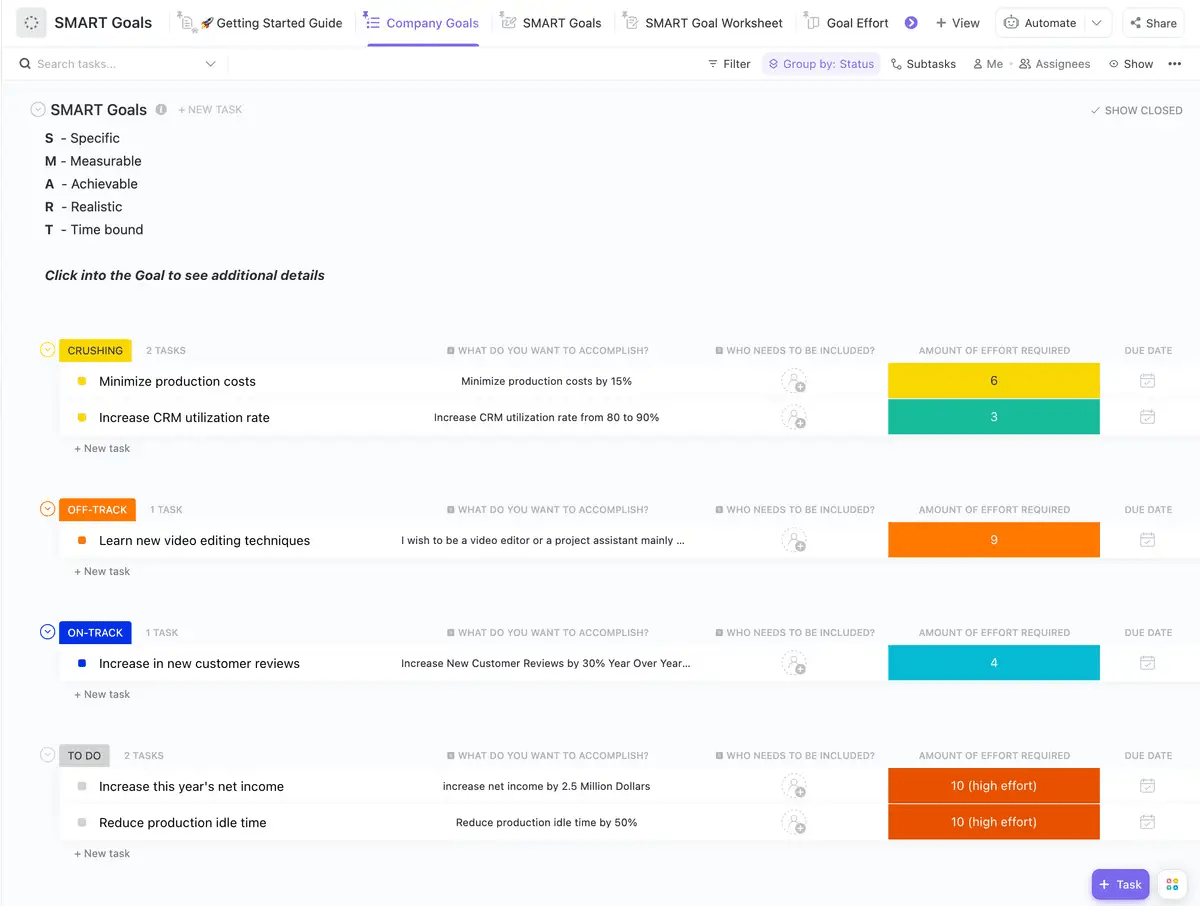
Step 3: Delegate authority and decision-making
A productive team is often an autonomous one.
In high-performing teams, leaders often decentralize power and authority by delegating responsibility to individuals. In some cases, you may also witness individual project ownership where team members take the lead on specific initiatives. As a result, the individuals and the teams establish a culture of trust and accountability where they have the power and authority to make decisions rather than relying solely on leaders.
They may employ decision-making frameworks such as decision logs to reach an agreement collaboratively. Decision logs maintain a transparent record of choices, the driving rationale, and resulting outcomes. Such a document becomes a valuable resource for future reference and learning.
Whether you are delegating responsibility or facilitating decision-making, ClickUp is an invaluable tool. It lets you assign roles and responsibilities among the various stakeholders. Roles like project owner, admin, member, guest, and custom roles offer granular control over information access and permissions.
You will also find helpful resources like a Decision Log template on ClickUp to help you make smarter, data-driven decisions.
The template makes tracking decisions easier by helping project teams document each decision and its rationale, monitor progress across a timeline, and analyze outcomes to distill learning for future decisions. It also helps to create transparency by letting all stakeholders see why certain decisions are made.
Step 4: Foster two-way communication
An environment that supports open and two-way communication is vital for effective teams. Two-way communication deepens understanding, cultivates trust, and strengthens the bond within the team.
Establish synchronous and asynchronous communication channels to allow members to share ideas, feedback, and any concerns freely.
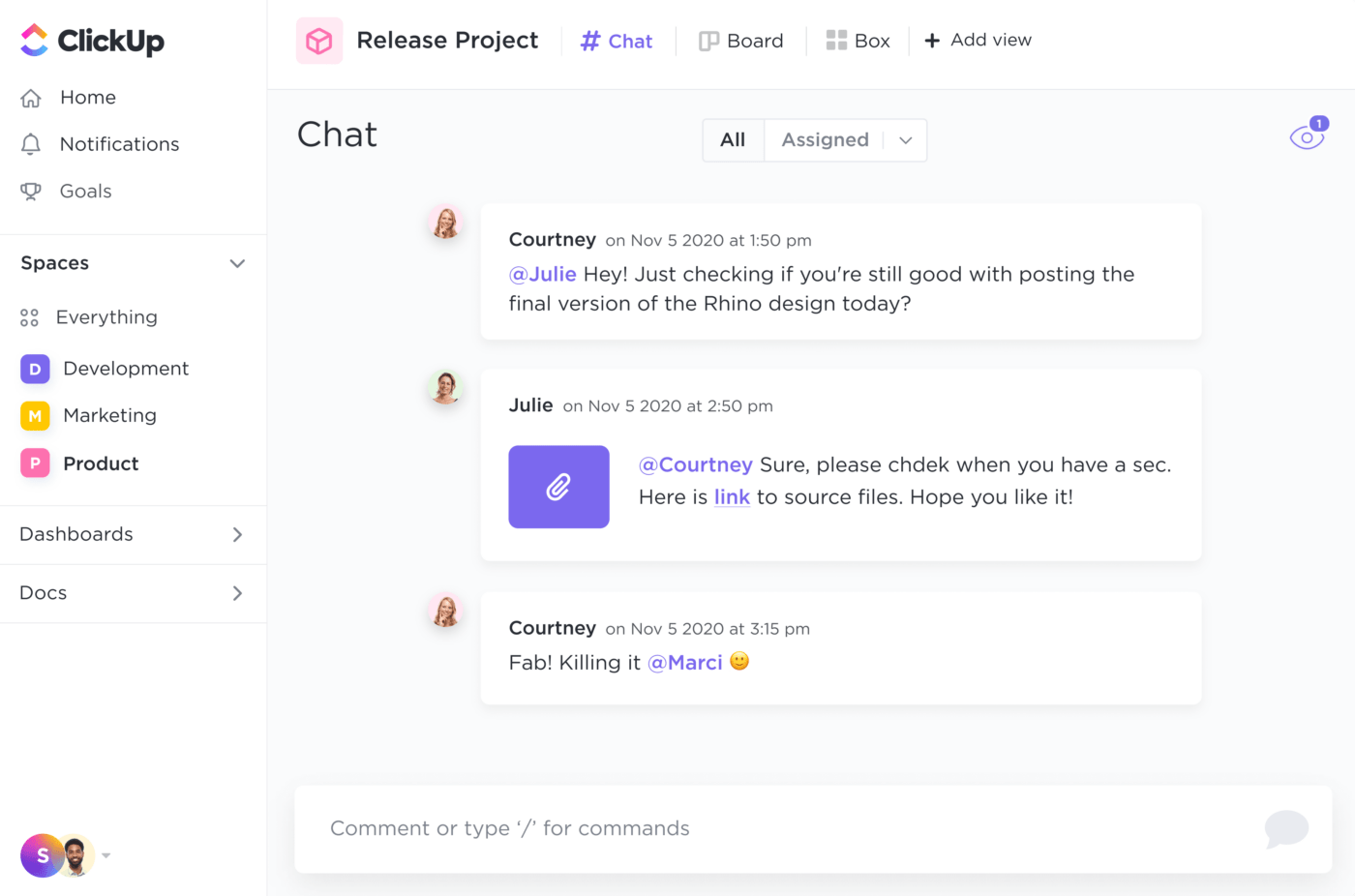
For instance, the Chat view in ClickUp creates dedicated chat threads where teams can communicate with each other in real time. You can draw someone’s attention to a specific message using @mentions or assign comments to action items.
Similarly, you can link resources, upload documents, embed webpages, etc., in the Chat View for quick reference. The Chat View can effectively replace emails; you can get all your information over a single platform.

ClickUp’s Collaboration Detection feature allows virtual teams to work on the same document or whiteboard simultaneously, regardless of location.
From adding tasks to assigning comments, you can view what others do in real-time while they work on the document with you!
Step 5: Extend support and share resources
Building high-performing teams involves committing to mutual support and sharing of resources. Leaders must actively facilitate an environment where members can freely seek assistance while overcoming obstacles.
Leaders can leverage ClickUp Docs to set up centralized resources. ClickUp Docs can be a one-stop platform for all resources, from interactive Wikis to all project-related documents. Members can add to this information, share it in Tasks and threads, offer feedback, etc., to enhance its value.
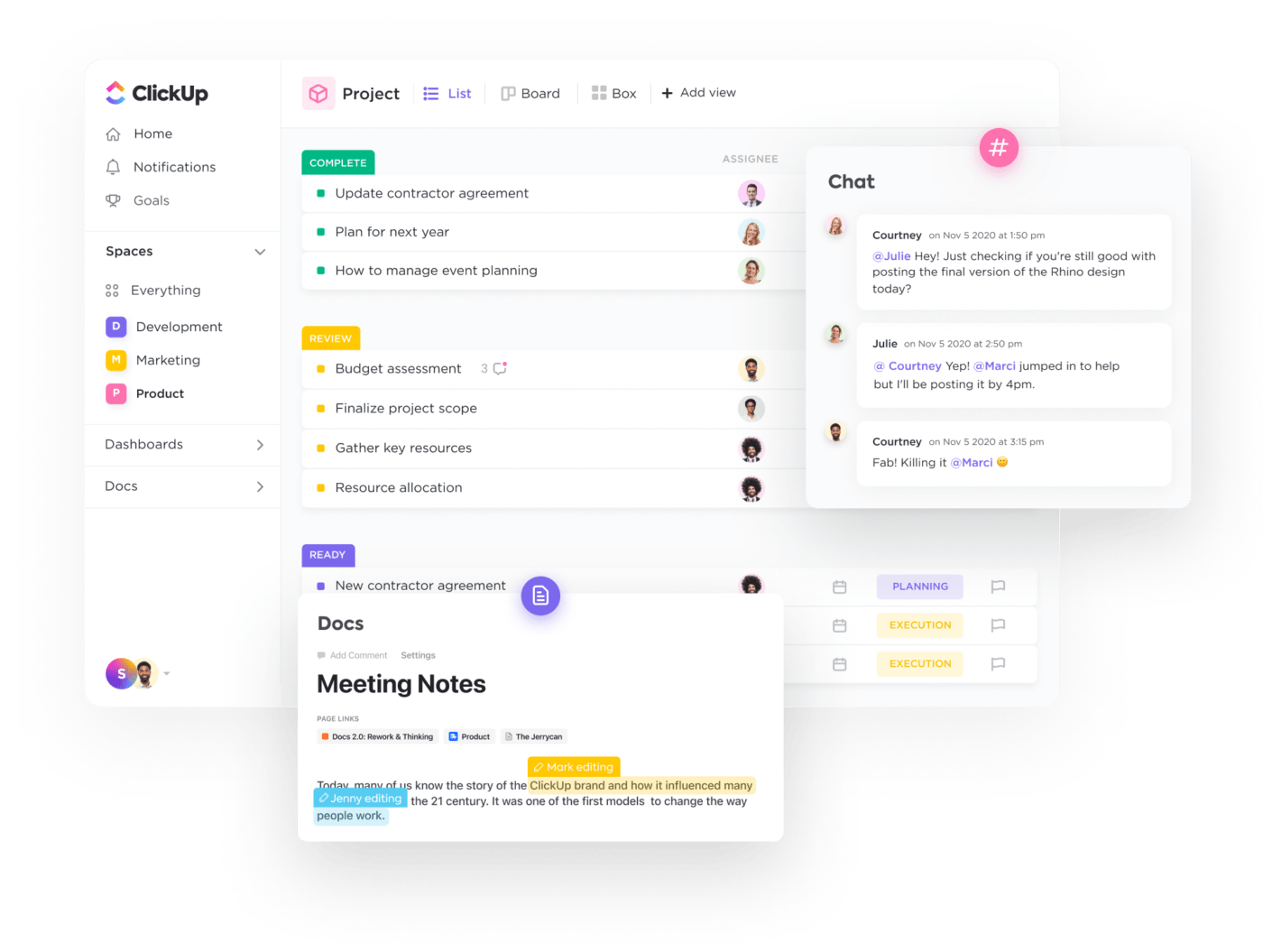
In addition to knowledge-sharing, leaders should provide training and professional development opportunities, expert assistance, one-on-one mentorship, and access to essential tools and technologies.
To help the team work more efficiently, leaders can identify appropriate solutions from over 1000+ tools and integrate them with the ClickUp ecosystem. Such modularity adds to the scalability of your high-performance team.
Enabling the team at every step ensures that high-performing teams continue delivering through a sense of collective responsibility and collaboration.
Step 6: Cultivate empathy and emotional intelligence
Empathy and emotional intelligence are vital traits of a high-performance team. Individuals with heightened self-awareness and openness to others’ perspectives can form a cohesive team. Such shared understanding and emotional connection sets the tone for a positive and collaborative work environment.
Leaders should build a work culture where individuals can recognize and respect their colleagues’ feelings, experiences, and diverse outlooks. Emotional intelligence will improve communication, resolve conflicts effectively, and nurture trust.
Empathy, by helping team members relate to each other’s circumstances, promotes a supportive environment where members step up to help each other in need. This creates a working environment that focuses on everybody’s overall well-being.
Step 7: Recognize contributions and celebrate achievements
High-performing teams acknowledge and celebrate individual contributions and team achievements.
Leaders should set milestones and celebrate the micro-wins while actively recognizing team members’ strengths and efforts.
Such a culture of appreciation that celebrates individual and collective successes will lead to highly motivated and driven teams.
To boost morale, leaders can set up project milestones to track and recognize exceptional efforts privately and publicly. This can also drive team engagement by showing individual members how their efforts contribute to the overarching goals.
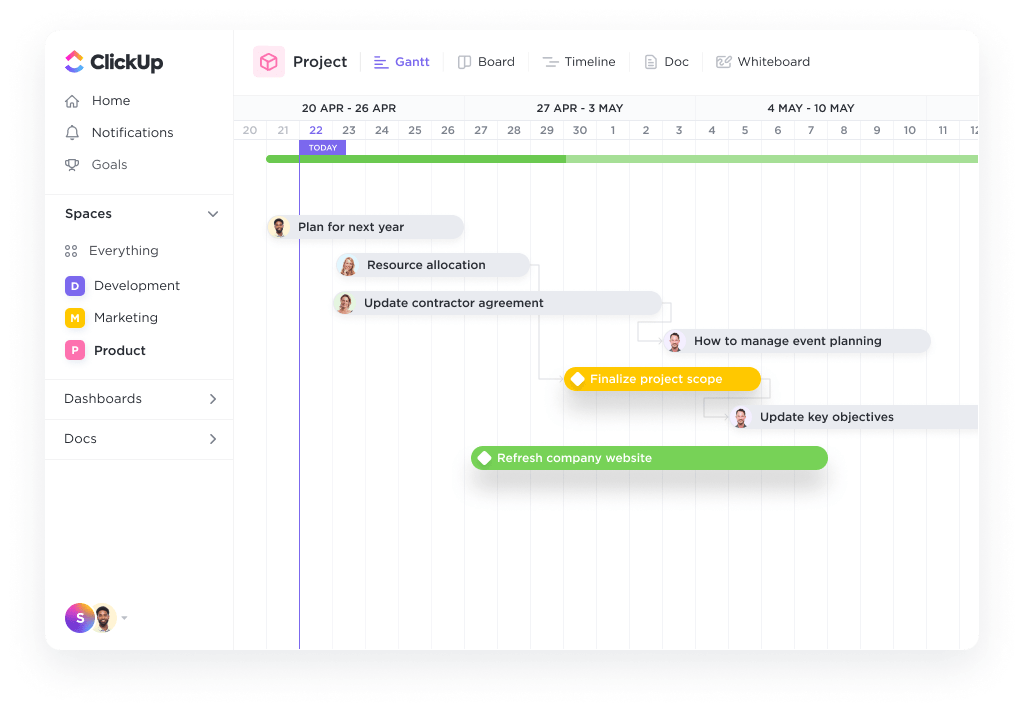
Simple rituals such as celebratory events, shout-outs, and awards as tangible expressions of appreciation can have a lasting effect on the team. The sense of achievement reinforces the team’s shared goals and boosts motivation.
Step 8: Maintain flexibility and adaptability
High-performing teams recognize that goals and circumstances may evolve. Such changes can affect the project scope, requiring teams to recalibrate strategies and adjust their approach. Their high-performance is evident from embracing these challenges rather than resisting them.
Autonomy and flexibility make such teams agile and responsive, enabling them to navigate uncertainties, maintain resilience, and excel despite evolving demands and complexities.
Use the ClickUp Change Management Plan template to bounce back from disruptions and sustain a high-performance team. Such a structured approach to managing changes keeps you in the driver’s seat even if the change seeps through the entire organization. Use the template to conquer change, one task at a time.
Step 9: Measure and assess performance
To build high-performance work teams, you must first decide what ‘performance’ truly means. Develop a qualitative and quantitative definition of performance goals and a way to measure and assess them systematically.
Typically, performance will be measured through metrics and key performance indicators (KPIs) that align with the team’s goals and objectives. Periodically, evaluate individual and collective contributions and benchmark them to prepare a historical performance record.

Once this background is ready, you can adopt performance management tools to regulate and streamline the process. Having insights into goal attainment, productivity, and areas of improvement can drive high-performance teams.
Leaders can also use these findings to share constructive feedback, identify strengths, and address challenges in a data-driven manner.
Regular performance assessments establish a culture of continuous improvement by fine-tuning strategies and ensuring everyone stays on the trajectory to success. Performance review templates can prove handy in this effort.
Step 10: Establish a feedback mechanism
Speaking of continuous improvement, building a robust feedback mechanism is the final step in building high-performing teams.
Develop a culture where open and constructive feedback is encouraged and paves the path for the team’s growth. Schedule regular feedback sessions where participants can share their insights, offer suggestions, and discuss challenges.
Leaders should stimulate and moderate dialogs in a candid and respectful environment. They must also be open to receiving input from team members on how they can steer the team better.

Such a structured approach to feedback promotes trust and transparency, fostering a culture of accountability, continuous learning and improvement, and shared commitment to excellence.
Read More: Effective leadership strategies to improve team performance
Overcoming Challenges in Building and Sustaining High-Performing Teams
Bringing together a team of diverse, high-potential employees and expecting them to work well together like a well-oiled machine can be a somewhat utopian thought. In reality, you may experience inevitable hiccups along the way. Here are a few challenges that you can expect while managing high-performance teams, along with some possible solutions:
Challenge: Resistance to change
Solution:
- Foster a culture that recognizes change as a constant
- Communicate the benefits of change, offer resources and support, and involve the team members in the decision-making process to increase their buy-in
Challenge: Lack of trust
Solution:
- Encourage team members to participate in team bonding and relationship-building activities to nurture trust and have open communication
- Conduct virtual team-building activities and host informal events so that teams can relax and unwind, allowing them to bond
- Cultivate trust through reliability, consistent actions, and transparency, and lead by example to inspire others to follow suit
Challenge: Confusion about roles and responsibilities
Solution:
- Define roles, KPIs, and success metrics for the team and each individual clearly from the get-go so that you and the team are on the same page regarding what defines performance
- Communicate these metrics regularly to the team so that they understand how they can deliver expectations
- Revisit roles and responsibilities periodically and inform the team of any changes
- Encourage cross-functional collaboration to promote flexibility and adaptability
Challenge: Team member disengagement
Solution:
- Align individual roles and responsibilities to the team’s larger goals to develop a sense of purpose and connection
- Recognize and appreciate contributions by celebrating individualistic milestones and achievements
- Give members a platform to voice their opinions and ideas and proactively address their issues and concerns
- Grant team members the opportunity to pursue professional growth and development which aligns with their aspirations and individual interests
Challenge: Interpersonal conflict
Solution:
- Train team members to leverage skills like active listening and open dialog to communicate issues and address conflicts promptly
- Introduce clear and standardized guidelines for managing conflicts
- Harness conflict resolution techniques like negotiation, compromise, and mediation to find middle ground
- Focus on a culture of empathy where teams can objectively share their views while also being sensitive about their implications
Challenge: Difficulty in collaborating remotely
Solution:
- Invest in collaboration tools and technologies so that the virtual team coordinate their activities
- Share employee handbooks or guidelines on the preferred communication channels and working hours
- Schedule virtual check-ins regularly and incentivize remote collaboration
- Offer training and support to remote employees to address any technical or logistical challenges
How You Can Build High-performing Teams: Recap
- Bring diverse capabilities and qualities together
- Create shared goals and a common purpose
- Delegate and empower
- Encourage two-way and transparent communication
- Provide resources and support
- Promote empathy and emotional intelligence
- Recognize contributions and celebrate milestones
- Value agility and adaptability
- Assess performance regularly and in a structured way
- Enable regular, constructive feedback
- Proactively address challenges through communication, enablement, training, and team-building
ClickUp: Your Enabler for Building High-Performance Teams
Building high-performing teams requires strong leadership, strategic vision, and a commitment to excellence. ClickUp can be your consistent partner through the journey. From cultivating a shared sense of purpose to rebalancing workloads, ClickUp is a powerful project management tool for building and sustaining high-performance teams. It helps in building a foundation of communication, collaboration, goal-setting, and continuous improvement to help teams succeed.
Sign up for a free account now.
FAQs
1. What are the six characteristics of effective work teams?
The six characteristics of effective work teams include
- Clear goals
- Open communication
- Mutual trust
- Diversity in skill and perspectives
- Strong leadership
- Commitment to continuous improvement
2. What are the 7Cs of team building?
The 7Cs of team building include Capability, Cooperation, Coordination, Communication, Cognition, Coaching, and Conditions.
3. What are the six key team processes of high-performing teams?
The six key team processes of high-performing teams include
- Communication
- Decision-making
- Conflict resolution
- Collaboration
- Learning and adapting
- Skill enhancement





